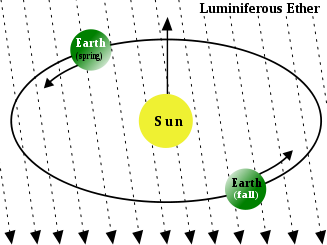
Current physics can’t explain why light waves travel at a fixed speed in empty space. Wave speed should vary with the medium, so the speed of a water wave depends on the elasticity of water. Nineteenth century scientists expected light to be the same, so its speed should depend on an ether that fills space. But the earth orbits the sun at 108,000 km per hour, and the sun goes round the galaxy even faster, so we can’t be stationary relative to that ether (Figure 1.4). It follows that the speed of light should vary with its direction but in 1887 Michelson and Morley discovered that it was the same in every direction, so there was no physical ether.
Einstein then traded Newton’s absolute space and time for an equally absolute space-time where:
“…absolute space-time is as absolute for special relativity as absolute space and absolute time were for Newton …” (Greene, 2004, p51).
He changed the question from how light vibrates empty space to how it vibrates a space-time matrix, even though the latter gives no basis for elasticity either. In an example of reverse logic, the speed of light is now said to define the elasticity of space, so a wave can define its medium of travel. The theory was fitted to the facts, which is backwards science!
To understand the problem, imagine a space that contains objects as an ocean contains fishes:
1. Any object in that space needs a not-that-object boundary to be an object.
2. Unless there are only objects, there must also be a “not-any-object”, i.e. empty space.
3. If that space is nothing at all, then only objects exist, so there is no basis for movement.
4. If that space exists as objects do, the logic returns to #1, so it needs another “space” to exist in.
Objects need a space boundary to exist but if that space is nothing at all, they can’t move, or if it is something, what bounds it? The buck of thingness must stop somewhere and for us space is it. The paradox is that space can’t be nothing, nor can it exist as the objects within it do. In a purely physical world, space is nothing at all, but both Einstein and Newton realized that was impossible:
“According to the general theory of relativity space without ether is unthinkable; for in such a space there would not only be no propagation of light, but also no possibility of existence for standards of space and time …” (Einstein, 1920, in May 5th address at the University of Leyden).
Einstein’s ether isn’t the physical one that Michelson and Morley dismissed, but a medium that acts like nothing but is something. A physical ether has been discredited, but a non-physical one has not:
“Since 1905 when Einstein first did away with the luminiferous aether, the idea that space is filled with invisible substances has waged a vigorous comeback.” (Greene, 2004), p76.
This “substance” has to be able to transmit light yet look like nothing at all. A physical substance can’t do this but a null process can. In computing, a null process is what a computer does when it is idle [1], so even if one isn’t pressing keys or moving the mouse, a 4 GHz computer still processes at about 4,000 cycles a second. Empty space as null processing has no output but it isn’t nothing, so it satisfies the requirements for a non-physical ether.
Matter doesn’t have a null element but processing does, so it can output an entity, like an electron or photon, and still represent empty space, just as a screen can show an image or not. Yet a blank screen without images is still doing something not nothing. Only turning the screen off stops it, but that also destroys any images on it, so if the screen of space turned off, our entire universe would disappear instantly, and us with it.
It follows that empty space is not empty at all but full of null processing.
[1] Null processing is the program that a processing unit runs when it is doing “nothing”.